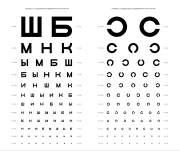
Golovin-Sivtsev Table
Encyclopedia

Soviet Union
The Soviet Union , officially the Union of Soviet Socialist Republics , was a constitutionally socialist state that existed in Eurasia between 1922 and 1991....
ophthalmologists Sergei Golovin and D. A. Sivtsev developed the table for testing visual acuity, that was used in the USSR and is still used in some post-Soviet states. This table is called Golovin-Sivtsev Table .
It consists of two parts, 12 rows each, at the left of each row the distance D (in meters) from which person with visual acuity value 1.0 can read the row is indicated. At the right the value V shows minimum visual acuity value that person should have to be able to read the row from 5 meters distance. Rows visual acuity values represent the 0.1–2.0 range.
The left part contained Cyrillic letters Ш, Б, М, Н, К, Ы, И in a definite order, with width of each character equal to its height, and the size of a first row character being 70 mm, in the second row it was 35 mm, and 7 mm in the last row. Right part of the table contained Landolt C
Landolt C
A Landolt C, also known as a Japanese Vision Test, Landolt ring or Landolt broken ring, is an optotype, i.e. a standardized symbol used for testing vision. It was developed by the Swiss-born ophthalmologist Edmund Landolt....
symbols.

